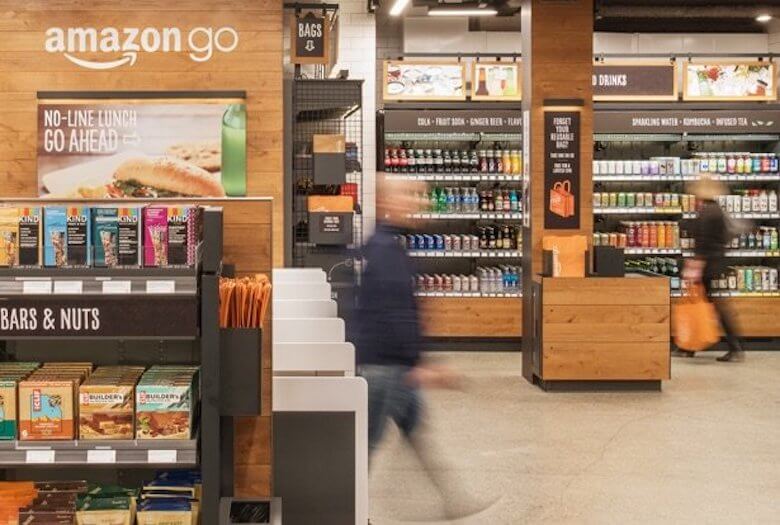Editor’s note: We’re chronicling how tech is changing the way we eat and drink as we lead up to this fall’s Food Loves Tech. Our annual deep dive into appropriate food and ag technologies returns to Industry City on November 2–3, 2018—stay tuned for updates and watch last year’s highlights here.
Amazon did it again. On its quest to automate our lives—and go where other businesses have failed to go (or haven’t even thought of going)—the retailer and tech giant opened Amazon Go last week in downtown Seattle. The store, which sits among the shadows of Amazon’s spherical campus, operates without cash—or cashiers. It is the first run of an automated grocery store, with this early version selling limited produce and pantry items, like flour and rice, bottled beverages, prepared foods and their proprietary meal kits.
The hi-tech quickie mart looks like a set for Mr. Robot or Black Mirror. Much like a subway turnstile, you swipe your Amazon Go app end to end, which activates your shopping experience. Between your smartphone and the cameras and sensors on the ceiling, your visit to the store is tracked from beginning to end. The shelves are lined with items you would see at your corner bodega: chips, paper towels, rice, seltzer water and Kraft Mac & Cheese. But instead of made-to-order sandwiches, the men and women in a cordoned-off kitchen prepare a roster of sandwiches and salads—all of which quickly sold out on opening day, leaving latecomers with cheerful “So Good It’s Gone!” signs.
Amazon’s goal has always been to make the lives of its customers easier. The company always specialized in one-click shopping, lightweight e-readers and straight-to-your-door deliveries and has since expanded its reach into food with the purchase of Whole Foods Market and by introducing its own restaurant delivery service, meal kits competitive with Blue Apron, and Amazon Pantry for bulk shopping. Go is a natural extension of the company’s too-easy shopping experience and resembles a staggeringly efficient Whole Foods with the aisles of prepared foods. (In fact, it seems Amazon has inherited some problems from cost-cutting efficiencies that Whole Foods recently implemented, as recent reports find Whole Foods around the country running out of basic items.)
The company’s employees have been shopping at the beta version of this store for some time and treat it as most of us would the café or newsstand on the ground floor of Manhattan office buildings. But the opening days of Go attracted tourists and passersby confounded by such a strange and impersonal yet intrusive store. The monitors on the ceiling know when you take an item from a shelf and when you return it. It tallies everything in your arms and when you leave, charges your Amazon account. Removed from the equation is idle chatter with a cashier, but Eater writer Chason Gordon noted that, after pausing for a few seconds to look at the camera-filled ceiling, a clerk rushed to his side offering help.
For some, the person-less shopping experience may be off-putting. Food is rarely a solitary act for so many, and even minimal interactions with a clerk add much needed socialization to a person’s day. (A study from UC Davis famously noted that shoppers at a farmers market have 10 times the social interactions of shoppers at a grocery store.) The Go stores would seem to push us further in this lonely, if still convenient, direction, in a similar way that e-comm food and drink services like Thrive, Drizly and Chewy eliminate our interactions with our local natural food store, liquor shop or pet store.
Similarly, requiring a smartphone to even enter the store bolsters the idea that both Whole Foods and Amazon are indulgences for the wealthy; the barrier to entry may discourage elderly and low-income shoppers from trying the ultra-convenient Go.
For now, Go remains an attraction akin to the Cronut, with lines snaking around the sidewalk, which ironically removes the convenience of a convenience store. As the store loses its initial sparkle, we can assume visits will be faster and new locations will open. One thing we know for sure is that Amazon will not stop innovating, gobbling the trillion dollar American grocery market along the way, to make shopping for both necessary and purely indulgent items easier for the masses.
Suzanne Zuppello contributed reporting.



